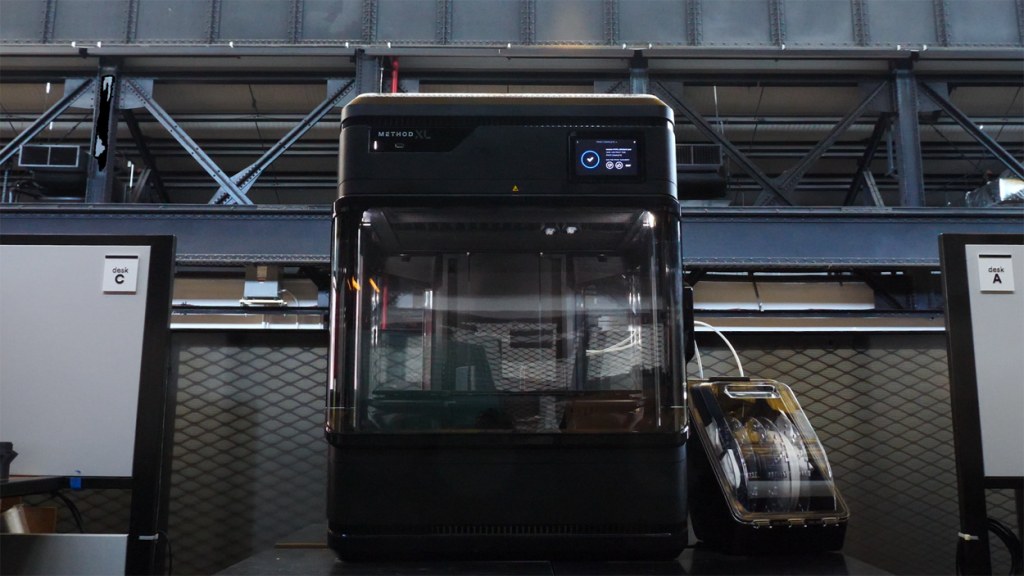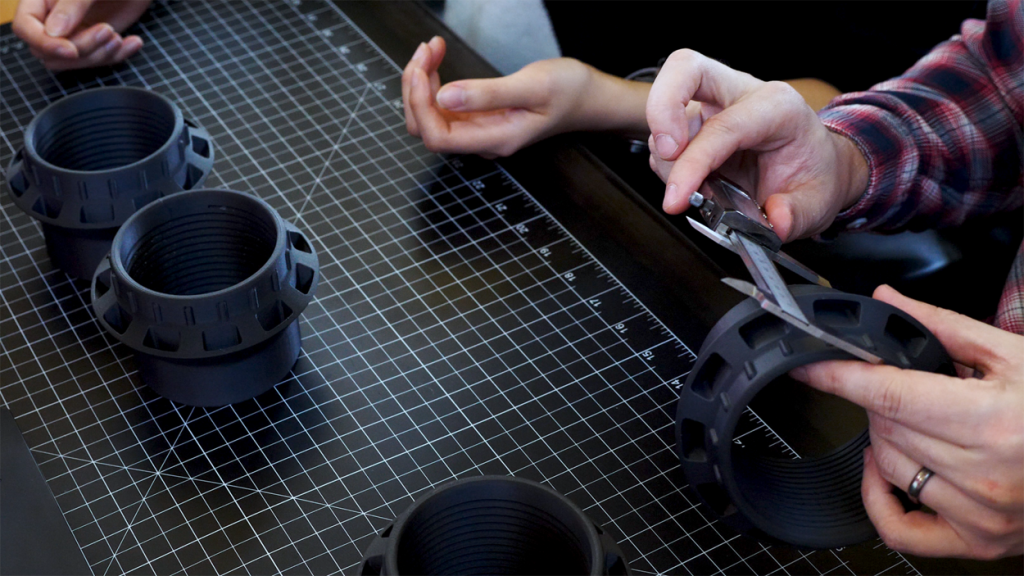Marking the Method XL 3D printer launch, 3D Printing Industry interviewed UltiMaker CEO, Nadav Goshen.
Our conversation covers a broad range of topics, including a particularly pervasive misconception, market conditions for desktop 3D printing, the role of AI in 3D printing, and UltiMaker’s philosophy.
You can read the technical specifications of the Method XL here.

A new direction for Thingiverse
Goshen also hinted at some exciting news with implications way beyond users of UltiMaker systems.
Whether working in the industry or enjoying 3D printing as a hobby, the 3D file-sharing platform Thingiverse was a core part of many people’s journey into 3D printing. Some in the 3D printing community have noted that despite Thingiverse still being the number one site, by traffic, for 3D printable files, it’s received less attention than it deserves from the development team over the past years. Goshen tells me that’s about to change.
“I want to apologize to the Thingiverse community for not investing much; we are correcting now,” says Goshen. “It is an amazing community out there. With this merger, we are shifting our focus back to Thingiverse,” he adds.
Thingiverse has an immense number of 3D printing models, yet since launching fourteen years ago, other similar services have arrived. For example, Cults3D offers a digital marketplace where users can buy files. MyMiniFactory initially differentiated by taking a curated approach – verifying designs for printability and has since expanded into selling designs, with a particular focus on tabletop gaming. Likewise, the relative newcomer, Printables by Josef Prusa has added the ability for designers to be rewarded. Plus, with Prusa’s roots in the open-source desktop world, it’s encouraging to see a new generation discovering work by pioneers such as Nophead. Furthermore, the company is adept at community engagement.
But given the now busy landscape for sources of 3D printable files, what’s next for Thingiverse?
Phase one is “creating a new team, truly focused on improving things.” Goshen notes that team is “very close to Cura,” the open-source slicer built by David Braam, who Ultimaker would later employ.
Goshen won’t say exactly what Thingiverse has planned. But given his background in software, previously running GrabCAD at Stratasys, and mention of Cura, it’s possible to speculate. And given that software in 2023 is synonymous with artificial intelligence, would it be far-fetched to see an AI offering?
Not only does Ultimaker have “the largest installed base and potentially the widest portfolio for desktop FDM printing,” but with its library of models, it has an immense training set of data that could be used for a machine learning or AI-based model.
Application of AI to 3D printing at UltiMaker is in progress, “We’re no longer thinking, we’re actually doing,” says Goshen. He has had an interest in AI and machine learning for many years and thinks that people sometimes confuse the two. For AI, “you need data sets to do training.” Due to the combination of the installed base, Thingiverse, and Cura, “Our AI strategy is very unique,” says Goshen. Without giving the details away, he says, “The value you can get from AI is really dependent on the datasets that you have access to,” adding, “You will see more from us!”.
“Our business model is yet to be released,” but it will include advertising. However, Goshen is more focused on “ways to unlock this value for the customers and the community.” “You will see it in the next year for sure,” he says.
The state of the desktop 3D printing market
The Method XL launch is guided by UltiMaker’s philosophy and mission, which, according to Goshen, is to prioritize user accessibility and innovation within the 3D printing industry.
Goshen explained that the Method XL addresses the challenge of printing ABS plastics, which require a heating chamber for successful printing. “In the sub-$20k price range, there hasn’t been a product that offers the capabilities to print ABS,” he stated. “The Method XL breaks that barrier by providing an enclosed space with a heating chamber, making it accessible, affordable, and easy to use for specialized engineering and injection molding applications.”
When asked about the target market for the Method XL, Goshen highlighted the demand for ABS plastics in both the late stages of product design and end-use parts. “Engineers and manufacturers who want to achieve optimal results or produce end-use parts often require ABS,” he explained. He says the Method XL caters to these professionals, providing them with a reliable, cost-effective solution that brings them closer to the final product.
3D printing with carbon fiber is also possible on the Method XL.
The conversation then turned to the current market conditions in the professional 3D printing category, specifically the sub-$20k price range. Goshen acknowledged the decline in 3D printer shipments within this segment but pointed out the lack of offerings in the $10 to $20k range. Most of the products available are either below $10k or above $20k he says. UltiMaker aims to target the $10 to $20k market with the Method XL, offering a high-quality solution at a more affordable price point.
Regarding competitors, Goshen mentioned various industrial players without naming specific companies. He emphasized that UltiMaker’s focus is on delivering reliability, durability, and accessibility to engineering professionals. The Method XL aims to provide a superior solution for industries such as aerospace, automotive, and manufacturing that demand high-quality 3D printing.

An obsession with speed?
Buyer behavior has evolved from a focus on price to an emerging obsession with 3D printing speed. This is evident not only in online challenges where users post the results of fine-tuning printers to produce Benchy’s at a rapid pace but also in features selected for highlighting by manufacturers. Goshen characterizes this obsession with speed saying, “I think there is a bit of confusion in the market.”
“I don’t think the movement of the extruder head translates directly to the speed that you have the final part in your hands,” says Goshen. Instead of a view that “isolates one element of the workflow,” a process that includes dual extrusion, support material, and post-processing, it is important to provide a “full picture to customers.”
“I think the desktop space is characterized by trying to address two different customers. One is the newcomers that have to learn. And they will learn because they’re seeing the difference between extruding speed and movement speed [compared to] the actual time it takes to get the parts in their hands [with] reliability. And the other space is exactly where XL is focused. The engineers and managers that want to use a professional grade solution in a proven application.”
Onto those applications.
Goshen says the world’s largest brewery provides an illustrative case study. They have adopted UltiMaker’s 3D printing solutions to produce spare parts directly on the production line. This application has significantly curtailed operational downtime by removing the need to wait for the spare parts to be delivered. This underscores one of the most compelling advantages of additive manufacturing – the capacity for on-site, on-demand production.
Goshen also underlines the value 3D printing brings to the field of automation and robotics in manufacturing. By offering a pathway to produce custom and flexible designs, particularly for robotic end effectors – devices on a robotic arm that interact with the environment – additive manufacturing is empowering industries to maximize their investment in automation technologies.
In industries operating in remote areas, such as oil and gas, 3D printing provides a solution for logistical hurdles. With the availability of 3D printers on-site, companies can manufacture necessary parts exactly when and where they’re required. This eliminates the necessity for complex and expensive supply chains and warehousing.
In 2016 news headlines appeared proclaiming “the death of MakerBot,” with one site going so far as to publish an obituary. My conversation with Nadav Goshen leaves the impression that sleep or hibernation may’ve been more appropriate. Away from the distraction of social media, the company’s 3D printing systems have made the tricky transition between market segments, moving into a middle market, professional spot. However, it is the stirring great bear in the form of Thingiverse that many will be watching.
What does the future of 3D printing hold?
What engineering challenges will need to be tackled in the additive manufacturing sector in the coming decade?
To stay up to date with the latest 3D printing news, don’t forget to subscribe to the 3D Printing Industry newsletter or follow us on Twitter, or like our page on Facebook.
While you’re here, why not subscribe to our Youtube channel? Featuring discussion, debriefs, video shorts, and webinar replays.
Are you looking for a job in the additive manufacturing industry? Visit 3D Printing Jobs for a selection of roles in the industry.
Featured image shows Nadav Goshen shaking hands with Juergen von Hollen on merger between MakerBot and Ultimaker. Photo via UltiMaker.



